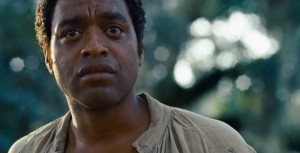film review: 12 years a slave
Brutish and unafraid to be bold, Steve McQueen’s 12 Years a Slave is a harrowing test of one’s limits. The adaptation (based on the nineteenth century memoir of the same name) follows the tremendous struggle of talented violinist and carpenter Soloman Northup (Chiwetel Ejiofor) in 1840s New York. Soloman is kidnapped and sold into the slave trade, despite being granted a free man.
Separated from his wife and two children, he is stripped of his former life and identity and shipped away to be held prisoner at the helms of his new owner, William Ford (Benedict Cumberbatch), a New Orleans plantation holder. Here, Soloman meets Tibeats (Paul Dano), a sadistic carpenter incredulous and loathsome of Soloman’s presence, eager to provoke a fight in order to indulge his racist desires for an excusable kill.
Despite being a slaveholder, Ford has compassion towards Soloman and chooses to sell him down the river to Epps (Michael Fassbender), a fellow slave trader and plantation owner. Epps, a brute and borderline psychotic who holds obsession with one of his slaves, Patsy (Lupita N’yongo), is yet another force that hinders Soloman’s quest to reunite with his family. Epps becomes the leading threat to his endurance, testing Soloman’s tether as he constantly abuses Patsy and other slaves in a release of self-loathing rage.
With such deterrents, refuge is found in Bass (Brad Pitt), a Canadian carpenter working within the plantation. Intolerant of the racial discriminations that plague North America, he stands to empathize with Soloman’s struggle and acts as his remaining source of mental and emotional stability.
Throughout the film, McQueen forces the viewer into claustrophobic proximity, exposing every gruesome act with unsettling detail. The film never shies to pan away from the violence and disallows the viewer a moment’s rest from the horror, a directorial achievement that rightfully simulates the incessant reality of the slave trade.
Although insisting that he doesn’t have a style, McQueen perfectly captures the relentlessness of human nature and the depths in which one is capable of reaching, a trope consistent within 12 Years and previous feature-length releases Hunger and Shame.
Scenes are filmed at uncomfortable intimacy and are indispensible to reveal the primitive nature of this dark period in American history. Every sizzling crack of flesh breaking, gurgle of spit escaping the throat of a noose tightening, and chain knocking against battered skin is filmed at such immediacy, the viewer is left mourning the prejudices of the past.
The film’s theme is one so emotionally dense that when dialogue fails to correctly convey the complex scale of sentiment and contempt, focus becomes dependent on facial and physical expression. Most visibly through each character’s eyes, a recurring trope for McQueen, these moments of silent visuals lead with imperative force to connect with an audience. The performances are nothing short of magnificent.
The slow pans across fields of laboring slaves while sermons are read and racist tunes are sung (most disturbingly Paul Dano’s tormenting ‘Run, Nigger Run’) add to a horrifying atmosphere that endlessly lingers and leaves you in disgusted disbelief.
As Soloman sacrifices his intelligence, literacy and creativity in order to survive, one can truly grasp the extent of human determination. Despite suppression and subjugation, survival is the priority.
Not only will this film challenge your emotional stability but leave you glad that Soloman Northup’s story has been told.



Pingback: 12 years a slave – film review | anthologc